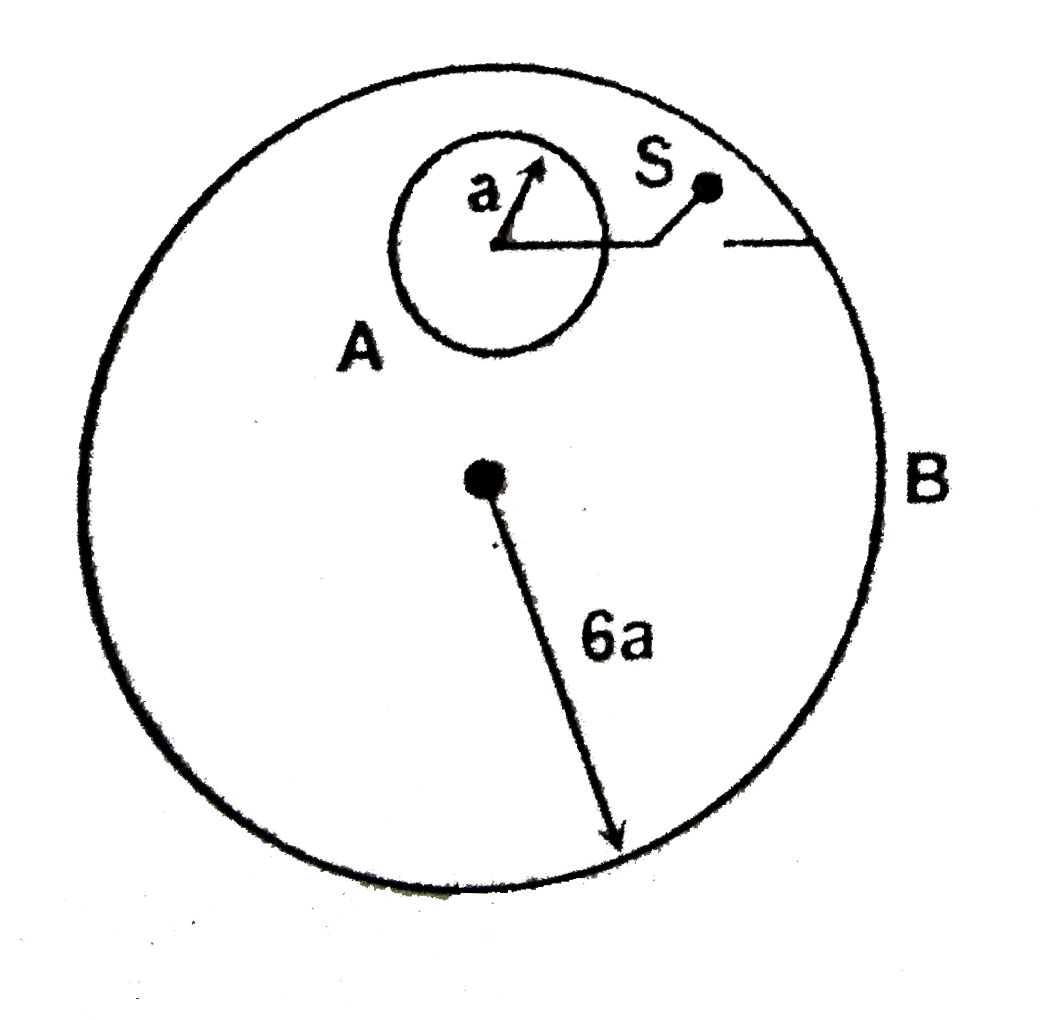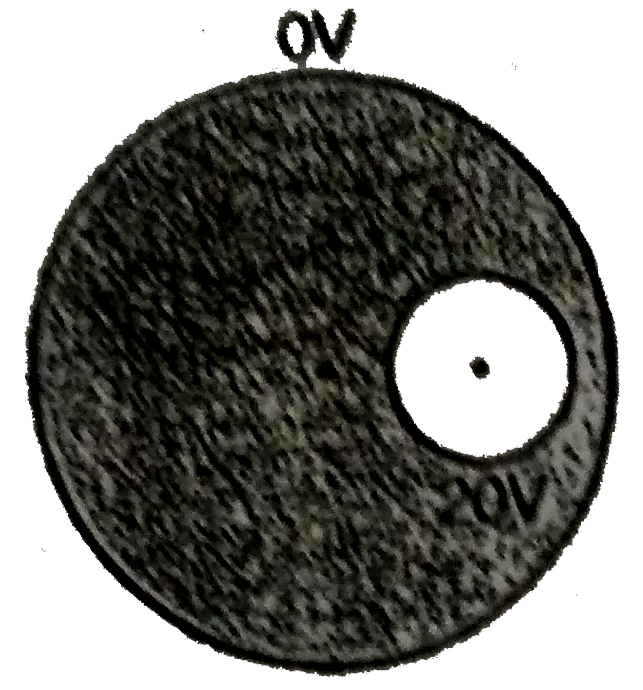If a conductor has a potential and there are no charges anywhere else outside, then
there must be charges on the surface or inside itself.
there cannot be any charge in the body of the conductor.
there must be charges only on the surface.
both (a) and (b) are correct.
The correct Answer is:C
To solve the question, we need to analyze the implications of a conductor having a non-zero potential V in the absence of external charges. Here's the step-by-step solution:
Step 1: Understand the implications of a non-zero potential
When a conductor has a non-zero potential V, it indicates that there is an electric field present. The potential being constant throughout the conductor means that the electric field inside the conductor is zero.
Hint: Remember that the electric field inside a conductor in electrostatic equilibrium is always zero.
Step 2: Analyze the absence of external charges
The problem states that there are no charges outside the conductor. This implies that any potential present must be due to charges located within the conductor itself or on its surface.
Hint: Consider the sources of electric fields and potentials in electrostatics.
Step 3: Determine the presence of charges
Since the conductor has a non-zero potential, it must have some charge distribution. This charge can either be on the surface of the conductor or within it. However, we know from electrostatic principles that charges in a conductor will redistribute themselves to the surface.
Hint: Recall that charges in a conductor will always move to the surface in electrostatic equilibrium.
Step 4: Evaluate the statements
1. There must be charge on the surface or inside itself: This statement is true because the non-zero potential indicates the presence of charge.
2. There cannot be any charge in the body of the conductor: This statement is also true because if there were charges inside, it would create an electric field, contradicting the condition of zero electric field inside the conductor.
3. There must be charge on the surface: This statement is not necessarily true; while there may be charge on the surface, it is not compulsory for there to be charge present.
Conclusion
Based on the analysis:
- Statement A (There must be charge on the surface or inside itself) is true.
- Statement B (There cannot be any charge in the body of the conductor) is true.
- Statement C (There must be charge on the surface) is not necessarily true.
Thus, the correct answer is that both A and B are correct.
Final Answer: A and B are correct.
When a conductor has a non-zero potential V, it indicates that there is an electric field present. The potential being constant throughout the conductor means that the electric field inside the conductor is zero.
The problem states that there are no charges outside the conductor. This implies that any potential present must be due to charges located within the conductor itself or on its surface.
Since the conductor has a non-zero potential, it must have some charge distribution. This charge can either be on the surface of the conductor or within it. However, we know from electrostatic principles that charges in a conductor will redistribute themselves to the surface.
1. There must be charge on the surface or inside itself: This statement is true because the non-zero potential indicates the presence of charge.
2. There cannot be any charge in the body of the conductor: This statement is also true because if there were charges inside, it would create an electric field, contradicting the condition of zero electric field inside the conductor.
Based on the analysis:
- Statement A (There must be charge on the surface or inside itself) is true.
- Statement B (There cannot be any charge in the body of the conductor) is true.
- Statement C (There must be charge on the surface) is not necessarily true.
Topper's Solved these Questions
- BOOK - NCERT FINGERTPS ENGLISHCHAPTER - ELECTROSTATIC POTENTIAL AND CAPACITANCE EXERCISE - HOTS5videos
ELECTROSTATIC POTENTIAL AND CAPACITANCE
- BOOK - NCERT FINGERTPS ENGLISHCHAPTER - ELECTROSTATIC POTENTIAL AND CAPACITANCE EXERCISE - EXEMPLAR PROBLEMS3videos
ELECTROSTATIC POTENTIAL AND CAPACITANCE
- BOOK - NCERT FINGERTPS ENGLISHCHAPTER - ELECTROMAGNETIC WAVESEXERCISE - Assertion And Reason15videos
ELECTROMAGNETIC WAVES
- BOOK - NCERT FINGERTPS ENGLISHCHAPTER - MAGNETISM AND MATTER EXERCISE - NCERT Exemplar5videos
MAGNETISM AND MATTER
Similar Questions
A hollow spherical conductor of radius r potential of 100 V at its outer surface. The potential inside the hollow at a distance ofr2 from its centre is
View Solution
A small spherical conductor 'A' of radias 'a' is initially charged to a potential 'V' and then placed inside an uncharged spherical conducting shell 'B' of radius 6a as shown. The potential of the spherical conductor 'A' after closing the switch S isView SolutionIf a charged spherical conductor of radius 10cm has potential V at a point distant 5cm from its centre, then the potential at a point distant 15cm from the centre will be
View SolutionTwo equipotential spherical surface having potential 20V and 0V are as shown in figure. There is no charge anywhere in space except on the surface of both the spheres. Then which of the following figure represents the nature of electric field in region between the spherical surfaces by electric lines of forces.
 View Solution
View SolutionTwo equipotential spherical surface having potential 20V and 0V are as shown in figure. There is no charge anywhere in space except on the surface of both the spheres. Then which of the following figure represents the nature of electric field in region between the spherical surfaces by electric lines of forces.
 View Solution
View SolutionIf 20J of work has to be done to move an electric charge of 4C from a point, where potential is 10V to another point, where potential is V volt, find the value of V.
View SolutionConsider a hollow spherical conductor that has a potential of 300 volts at its outside surface . The potential inside the hollow must be
(a) Zero at the center and rising to something less than 300 V at the edge of the hollow
(b) Zero at the outer part and rising to 300 volts at the centre.
(c ) It depends on the ratio of outer and inner radii
(d) Zero everywhere
(e ) 300 V everywhere
(f ) 150V everywhereView SolutionIf a charged spherical conductor of radius 5 cm has potential V at a point distant 5 cm its centre, then the potential at a point distant 30 cm from the centre will be
View SolutionA number of spherical conductors of different radius have same potential. Then the surface charge density on them.
View SolutionAt a certain distance from a point charge, the field intensity is 500Vm and the potential is −3000V. The distance to the charge and the magnitude of the charge respectively are
View Solution
